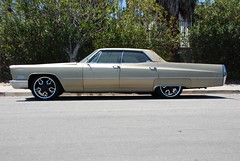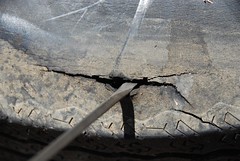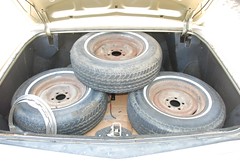 So, one of the first purchases I made for the Cadillac was a set of new wheels. I knew the Cadillac needed tires, since the rears were showing obvious sings of dryness and cracking. I also knew I didn’t want to “waste” money on buying tires for the stock wheel size when I knew I wanted to replace the wheels. Well, the passenger rear tire gave out after less than a week parked in the cul-de-sac. I saved my pennies and ordered up the tires at the beginning of the week, and they arrived at Big Brand Tire late Thursday night.
So, one of the first purchases I made for the Cadillac was a set of new wheels. I knew the Cadillac needed tires, since the rears were showing obvious sings of dryness and cracking. I also knew I didn’t want to “waste” money on buying tires for the stock wheel size when I knew I wanted to replace the wheels. Well, the passenger rear tire gave out after less than a week parked in the cul-de-sac. I saved my pennies and ordered up the tires at the beginning of the week, and they arrived at Big Brand Tire late Thursday night.
 The wheel is a Forte F36 that’s 20x8.5 with a +15mm Offset and the 5x5 bolt pattern of the caddy purchased from Gear Works on eBay. The tires are Kumho Ecsta SPT 245/40R20 front and rear, purchased from Tire Rack. I had wanted to keep the wheel size down and keep some sidewall on the tire. Lots of people are installing 22” and 24” wheels on these cars, and I think it’s a little excessive. In fact, even the 20” installed leaves a little less sidewall than I’d ideally prefer, but it’s too late now!
The wheel is a Forte F36 that’s 20x8.5 with a +15mm Offset and the 5x5 bolt pattern of the caddy purchased from Gear Works on eBay. The tires are Kumho Ecsta SPT 245/40R20 front and rear, purchased from Tire Rack. I had wanted to keep the wheel size down and keep some sidewall on the tire. Lots of people are installing 22” and 24” wheels on these cars, and I think it’s a little excessive. In fact, even the 20” installed leaves a little less sidewall than I’d ideally prefer, but it’s too late now!
I’ve generally had excellent service from Big Brand Tire, but they were having a rough day when they were installing my tires it seems. First, when I went to pick up the wheels with the tires mounted on them, they had neglected to gather together the Tire Rack invoice, Kumho warranty documentation, and the plastic center caps for the wheels. Then, only moments after getting them home I get a call. Turns out they’d accidentally installed the wrong tires on the car! They’d put someone elses Michelin 255/35R20’s on my wheels. I hadn’t noticed because the tread pattern and size were VERY close to the tire I had ordered, and as I said I’ve always had good service and expected that they’d done it right. Ahh well, I’ll still be using them, but it was a bit of a comedy of errors. (Mental note 255/35R20’s are a decent fit!)
Installing this wheel/tire combination was fairly difficult, especially in the rear. I had to jack the car WAY up and let the rear axle droop completely in order to slide the old wheel/tire combo out and the new ones back in. The deep wheel wells are a great design feature of the Cadillac but makes it tough to wrestle a tire up into them. The other surprise came when I was putting on the very first wheel on the rear. I put the new wheel on, and it didn’t seem to ever sit flush against the brake drum. I forged ahead with putting the nuts on the studs, hoping that the weight of the wheel was what was preventing me from pressing it up flush against the brake drum. After snugging all the lugs it didn’t seem to rock anymore, but I still wasn’t confident. It wasn’t until I got to the other side that I realized the problem. There is a small bolt that bolts into the hub through the brake drum. The back of the wheel is machined flat, where as the stock wheel has a relief in it allowing for this bolt to be installed. I simply removed this bolt on both sides. Not sure if it’s “necessary” but I doubt that the added strength of a 1/4” bolt on a surface held together by all 5 wheel lugs is going to make a difference.
You may recall from Day 1 Triage that the brakes seem to have failed on the Caddy. So while installing the wheels and tires, I also attempted to bleed the brake system. This too, was a bit of a comedy of errors. I have the correct tools for loosening the bleed screws, however even these don’t have the clearance necessary to really get a good “bite” on them. I managed to open them up, and do some bleeding, but my bleeding tool also wasn’t great. If anything I think I may have introduced more air into the system. I’ll have to re-try again later, probably with a custom built tool to loosen the bleed screws and a better bleeding tool.
After bleeding the brakes, and getting the new wheel/tire combo on I wanted to see if I had any brake left at all. I was convinced that the brake system had a serious failure because the cadillac has an automatic system for releasing the emergency/parking brake when the car is put into gear. This mechanism depends upon the brake being depressed, and uses a pressure sensor in the system to determine if it is “safe” to release the parking brake. After the car was delivered, the parking brake was never released when the car was put into gear. After my botched bleeding attempt, there was some trepidation, but I manually released the parking brake with a small lever under the dash. The brakes held! I then took it for a brief victory drive.
Of course, to get the car started in the first place, I had to grab the battery from the X. Seems there is a draw in the caddy which slowly drains the battery when it is not driven. Worse still, in swapping the battery in, I noticed that the positive (+) cable is routed through the radiator support, and is likely to get worn through and short to ground. Going to have to re-route that post haste! Mark up two more things for the todo list. :–)
The drive was good, it is missing a bit at full throttle. Also when you floor it there is a hesitation before the engine responds. Some carburetor and timing attention is in order. Taking it out for a spin also reminded me that I still need to replace the water pump and get the cooling system working. But, progress none-the-less!
Ohh and, if there was any doubt that this is a big car, here’s the proof. 4 fullsize tires in the trunk!
